Think about how often you see brands shouting their messages at their audience. No engagement, no context, no conversation.
Those brands look spammy and self-centered, not exactly trustworthy.
Brands that foster community on the other hand clearly care about their customers. They converse with their customers, sometimes even one-on-one.
They want to learn more about their interests, needs, and behaviors. They want to solve their customer’s problems.
As a result, their customers care about them and what they have to say in return. They become loyal to these brands.
Tip your hat to those companies. They knew how to build an online community.
Here’s why.
The value of building (or growing) a community
A community is a place for inclusion; a place where people bond over a common interest, passion, or purpose. It’s a place where relationships are built.
For businesses, a community is a place where your customers build relationships with each other and your brand. Here are four reasons why that matters.
1) Community adds value for your customers
Your community is a resource for your customers. A place where they can find information and answers quickly. They can bounce ideas off of each other and work through problems. They can meet new people who share their passions and interests. People go to communities to feel accepted and nerd out over interests.
The CloudPeeps community is one of the strongest examples of inclusion and added value I've seen. The company is a marketplace that connects businesses with freelance community, content, and marketing professionals.
Aside from access to jobs, CloudPeeps adds value for its freelancers (Peeps) with a tight-knit community where they swap advice, stories, solutions, and interesting content.
The community is hosted on a Facebook Group that sees several posts per day, all with high engagement.
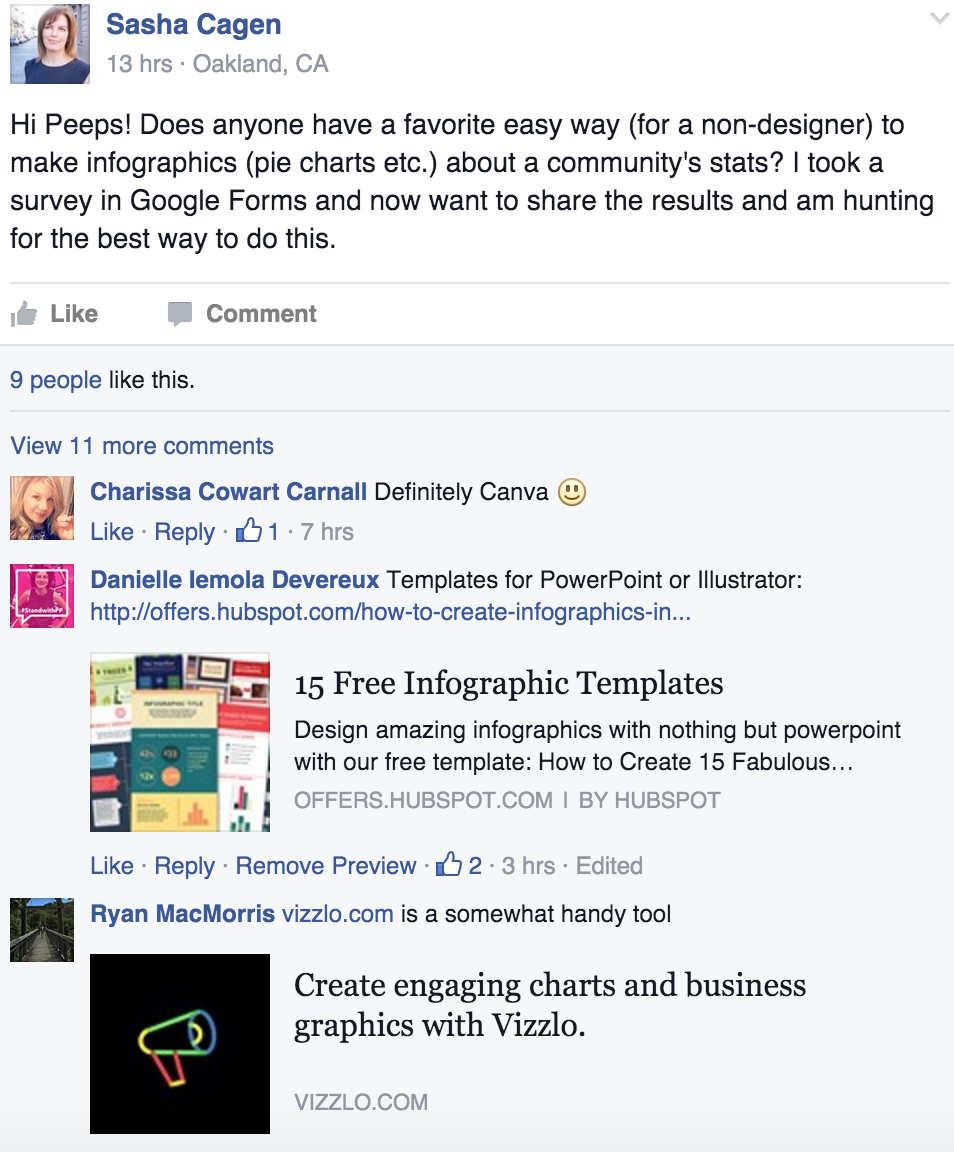
The high level of expertise and experience of the talent on the platform is what gives CloudPeeps its competitive advantage. The community helps keep and grow that talent, adding value to both the supply and demand side of the marketplace.
2) A community is a giant focus group
At the risk of sounding creepy, you’ll learn far more about your customers’ needs and interests by observing them talk to each other than you ever will with a survey.
Don’t get me wrong, I love quantitative data, but qualitative let’s you learn more about who your customers are, rather than what they think they want.
Even if a customer is happy to answer your survey, they’re going to answer questions with a customer hat on. They’re going to be thinking, “how’s this going to impact my experience in the future?”
On the flip side, if they’re in a casual conversation, their guard is down. Their thoughts and ideas will be open to other opinions and influences.
David Spinks and the CMX crew spark meaningful and relevant conversations within their Facebook group all the time. The magic really happens when people outside of the community post thought-provoking comments.

CMX hosts conferences, meetups, workshops and content for community professionals. A post like this gives them insight into what their audience is interested in without having to ask! It also allows them to lead the conversation.
They can then build content or a conference panel around the topic with more in-depth analysis. Thanks to the commenters, they even have ideas for potential speakers.
3) A community is where brand ambassadors are born
Some customers will be so excited about your community that they’ll get other friends to join. They’ll talk about your brand with their networks on and offline. They’ll ask how they can help. They might offer a blog post, ideas, user testing, or to even go to events on your behalf. The options are endless.
Having a customer wanting to shout from the rooftops about you is priceless.
Look at Product Hunt. The site’s community members are so passionate that some have created spin-off communities. One being MakerHunt, an incredibly active Slack community with more than 1,200 members.
The Maker community receives value through swapping advice, stories, and resources. They're also given access to influencer AMAs, early access to Product Hunt features, and more.
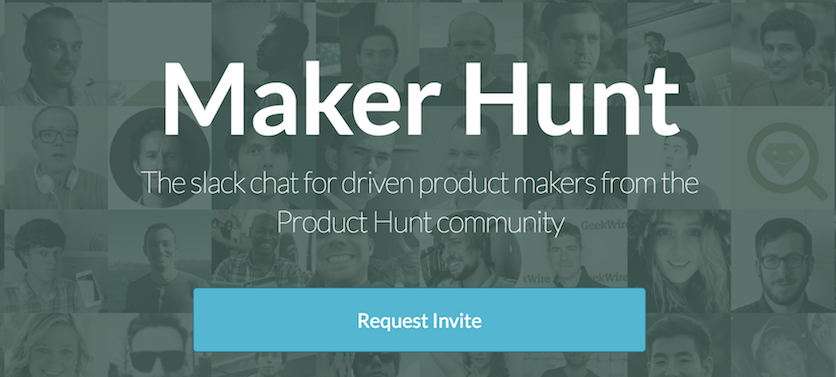
Product Hunt, in turn, has a captive audience and a pre-formed group ready to beta test and share new features at any given time.
4) Community drives retention
Your customers are more likely to stick around if they have a community they feel tied to. If there's any doubt whether a community will generate a return on your investment, consider this:
- Increasing customer retention rate by 5% can increase profits by up to 95% over the long-term (HBS)
- Increased engagement on community sites can result in up to 25% increase in revenue (MSI)
- Friend recommendations are the number one influencing factor in purchase decisions (Brand Advocates)
- It costs 80% less to retain a customer than to acquire a new one
Now you have more clarity as to why you should create a community and what it could mean for your business.
Do you know that you have something of value your customers want to talk about?
Do you think your customers could learn from one another or find value in connecting?
If your answer to either is yes, it's time to start community building. Let’s go!
Community best practices
{brake squeal} Before diving into the steps for building a community from scratch, let’s quickly cover some basic best practices even the youngest of communities should consider. These will help ensure that it runs smoothly, even when starting small.
-
Focus on a niche to start: Why should someone participate in your community? What’s a popular (and relevant) topic that doesn’t have a community around it? Focus on that and let your community split into sub-topics organically (more on this below).
-
Have guidelines: There’s a reason why even Fight Club had rules. Guidelines prevent anyone ruining the experience for others. They also clearly state upfront that anyone who does will be asked to leave, making that conversation slightly less awkward if it ever comes up. Keep your guidelines simple to start: No spamming, be kind, be generous, only share relevant content, etc.
-
Create a habit: Product Hunt was a success because it was addicting. It’s earliest community members looked forward to seeing the email in their inbox every morning. Make your community a habit with email, notifications, assignments, making members accountability buddies, etc. Find a way to ingrain your community in their every day (or at least weekly) lives.
-
Ask for feedback: Touch base with your members regularly to see how they’re doing, what they’re getting out of the community, and how you can improve the experience for them. They’ll appreciate that you care and it will keep them engaged.
How to Build a Community
Here are five simple steps — consider it your foundation — you can take to build an online community from scratch.
Step One: Start small
Like most things, a community isn’t going to be huge on day one. The most successful communities often start as small email lists, friendly dinners, forum threads, etc.
They later grow into something significant as you learn more about its value, and as its members become autonomous ambassadors.
Starting small takes patience and doing things that don’t scale, but the effort pays off in the long-term.
Ryan Hoover started Product Hunt as a small email list for friends to share cool products they’ve found. After much market validation (positive feedback and word spreading), Ryan saw the opportunity for a real site and community.
In March of 2015, Product Hunt saw its 1,000,000th upvote and that email list of friends now has more than 43,000 subscribers.
To get there, they talked to their community members (Ryan was kind enough to get on the phone with me when my product blew up overnight), hosted brunches, made incremental changes, and kept their members in the loop the entire time.
By starting small, testing, and iterating, you'll find ways to scale your community you would never see on day one. To illustrate, here’s my own experience.
I started a music discovery service called A Song A Day by total accident in 2014. I had an idea, built a landing page, bought a domain, went to bed, woke up, tweeted it, and it went viral.
I originally intended on sending a song to a group of friends every morning. After trending on Product Hunt for an entire day, I had hundreds of people expecting personalized song picks the next morning. Oops.
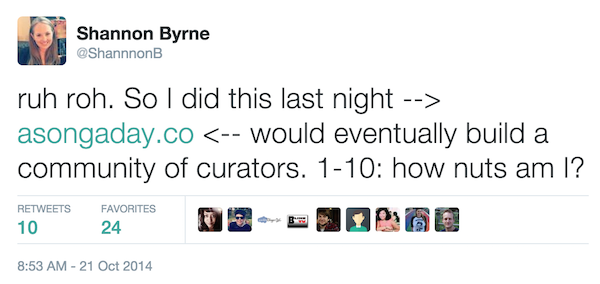
Although I tried to go at it myself for a week, that clearly wasn’t scalable.
Fortunately, there were plenty of people who loved sharing music and wanted to help. I started with a small ‘pilot’ group of curators to help me find and send songs. I chose about ten people: some close friends, internet friends, and a couple of wild card strangers just to see what happened.
With this, I was able to test different processes while we figured out what worked best. I communicated with them via a private Facebook Group and sent periodic surveys. Once we had a solid process and even more subscribers, I began bringing on more curators who matched our listeners’ needs.
Today, we’re a community of 45 curators sending songs to 3,500 listeners. More than 500 people have shown interest in becoming a curator! We’re a tight knit group always sharing music, insights into our processes, show announcements, industry news and more.
Many of our curators have become close friends and meet up regularly for get-togethers and shows. Some of them are even making music together! They’re what keeps me going whenever I'm overwhelmed. I hope to continue to scale this community as we continue to scale our process.
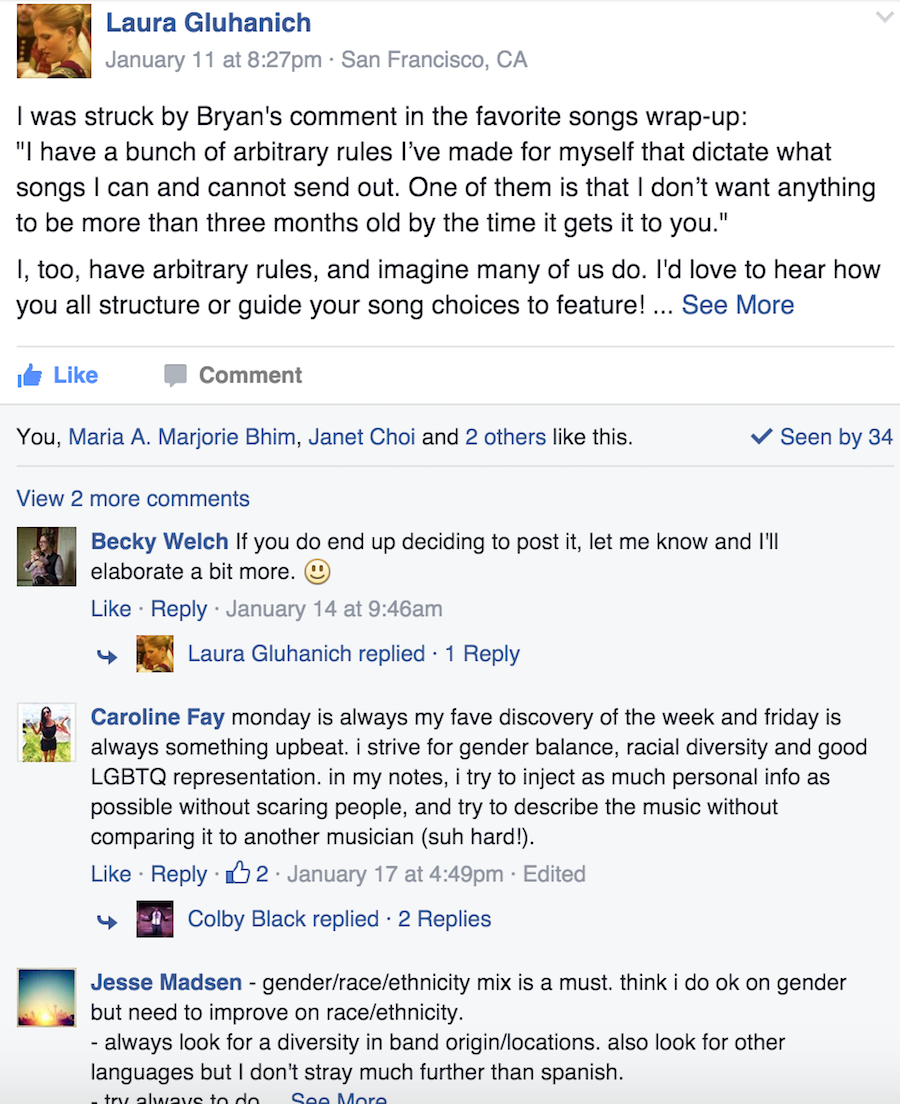
Here’s the resulting blog post of this conversation.
Action: Choose a handful of people to share your idea with. Get an email list going or create a Facebook group or Slack channel. Kick it off with a few conversation starters and see where it goes.
Step Two: Add a layer of exclusivity
Exclusivity goes hand in hand with starting small. Some communities keep membership low to keep quality high. Others find a way to grow and maintain that quality.
Going back to the Product Hunt example – when they first launched the site, they kept ‘hunter’ rights limited because it would’ve been too much to manage if they opened it up to everyone.
This made those with hunting rights feel special and it made more people want in. They eventually added referrals via invites so early members could invite their friends to join. This spread the word of PH and made the hunters feel special … again.
Quibb, a community for sharing quality content, has followed a similar path. Only members who have been invited or approved are granted posting rights.
This has helped the platform avoid becoming the problem it seeks to solve. Quibb started as a way to find quality content that was getting lost in the noise of Twitter. Exclusivity keeps quality and engagement high. Quibb is one of my first go-to sources when I’m curating content for clients for this exact reason.
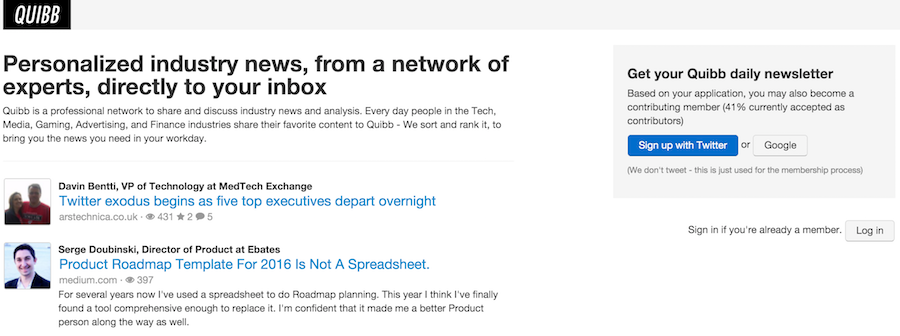
We all want to be the first to try something. We all want to be the first to talk about something new. Call us vain, but it’s fun introducing people to new things — to be an early adopter.
Action: Invite a small, exclusive group to join your community while you gain a better idea of what value your first community members see in it. Tell them that they’re the firsts and that you’re keeping it exclusive – communicate what’s in it for them, and who else is involved!
Step Three: Instill an ethos of helpfulness
Your community members are there more for each other than they are for you. They’re looking for a resource — a safe place where they can connect over passions and interests.
By creating an ethos of helpfulness, you’re creating an open environment. A place where your customers or community members can learn and share. And once they’ve learned from others, they’ll be likely to return the favor.
Geckoboard recently created a community around helpfulness for developers who use their product. Geckoboard has several (over 60) integrations for creating KPI dashboards. For tools they don't have an integration for, they found that customers were creating custom widgets.
They were impressed with what customers were building and assumed that if one customer found a custom widget useful, so would others. So they gave them a place to share and discuss the hacks, tricks, and custom widgets they’re developing.

Less than a month old, the community is already pretty active – impressive for a product-specific community
As a result, the community gives Geckoboard a clearer view into how their customers are using their product. They can now build stronger features more tailored to their power users’ needs. Plus, customers get to nerd out over data, engineering, sales, and marketing-related topics.
A less product-focused example is the community built around Vinyl Me, Please — a monthly vinyl club. As a consumer brand, VMP went a step further than encouraging social engagement (although, they're good at that too).
They created a vinyl resource: an active forum where members ask and answer questions about vinyl, music discovery, hardware, and more.
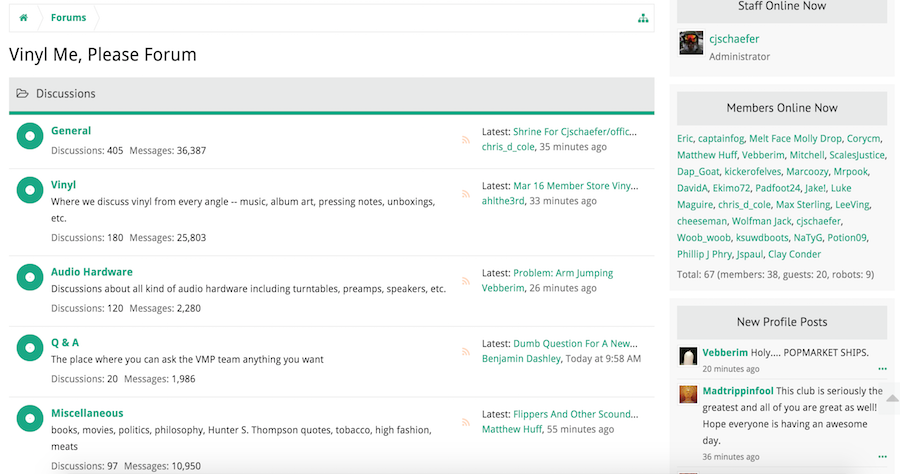
Action: Add value for your customers by creating a hub for relevant information and research.
Step Four: Make connections and let go
Erik Martin, former GM of Reddit once said in an interview:
“You’re not as smart as your users collectively. Just listen more and trust that the people who are passionate about the subject matter are going to do interesting and unexpected and amazing things with control you give them.”
As the community builder and facilitator, it’s your job to connect your members — get the conversation going, then step away. You can always chime in to answer questions, clear up misunderstandings or share announcements. The point is to allow your customers or members build connections with one another.
It's more difficult with forums, but with Facebook groups and Slack channels, your community can break off into smaller groups to discuss sub-topics and areas of interest. Or they can direct message each other to build deeper one-to-one relationships. If you’re worried about losing control, don’t be. Your community will be grateful for the relationships you opened up for them, and therefore remain loyal.
A great example is the #Nomads Slack community created by Nomad List where more than 10,000 digital nomads get together to discuss travel, work, new opportunities, and more.
As the facilitator, Nomad List has the opportunity to be their number one resource and in turn, learn about trends and interests among their community.
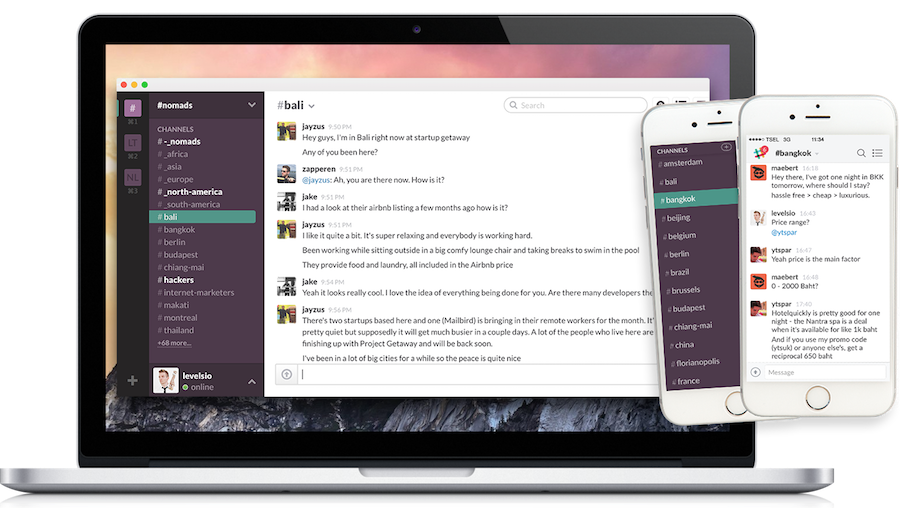
Youjin Do, director of One Way Ticket – a documentary on digital nomads – found her crew and most the people she interviewed on #Nomads.
Action: Bring a few customers together in a hangout and see what happens.
Step five: Spread the word about your community
Once you have a solid foundation – let’s say five to ten people engaging regularly and clearly getting value from your community – it’s time to enter stage two.
You’ve learned more about the value your community adds to its members’ lives. You have an idea around what sparks engagement and what doesn’t. You’ve developed and distributed guidelines based on past behaviors and lessons learned.
Now it’s time to add some members and work your way to scaling. There are several ways to do this, and the most effective will depend on the type of community you run. There are, however, several best practices that have proven effective for many.
A referral program: As mentioned, the Product Hunt and Quibb communities allowed early members to invite people to join. Ello did the same thing. The assumption is that if your early community members contribute to the community in a meaningful way, so will their friends. They’re only going to invite the best of the best.

Referrals are a way for members to share this cool thing they’re a part of while spreading word of your brand. The most effective referral programs reward referrers. Rewards might include swag, early access to exclusive features, event tickets, product discounts, partner discounts or freebies, etc.

Some referral programs use points systems. If your collective community has an ounce of gamer in them, they’ll get excited about a leaderboard. They might even get a healthy competition going, adding another layer of engagement.
Tiered-invites: You likely have Tier-A customers (hyper engaged, super loyal) and Tier-B customers (moderately engaged, loyal). When starting small, invite Tier-A first. Then, once you have processes and guidelines in place, invite Tier-B. And so on. This is slow and smart growth at its best. SaaS programs like Intercom (CMS) or NomNom (feedback insights) are helpful in identifying your most engaged customers.
Your newsletter: Don’t have one? Shame on you. (Just kidding – but seriously, here’s why you should have one and here’s how to build your list). Once you know you can manage a larger community, spread the word to your existing customers via your newsletter. Let them know the goal of the community and the value they’ll find.
Your social channels: Hopefully your social audience is relevant to your offering and pretty engaged. Once your community is running smoothly and you have a tight process in place, unleash the hounds! I mean, announce it to the world. Share highlights, wins, and insights from the community. Give your broader audience a taste of what they’re missing and why they joined. The Geckoboard community saw a big spark in interest simply by announcing their dev community on their blog and social.
Invite influencers: If your community is open to the public outside of just customers, it could be effective to get an influencer involved. Better yet, maybe one of your customers is an influencer. Find someone who’s relevant to your community and will truly add and gain value from being involved. When you reach out, make sure you communicate that value to them – what they’ll get out of it.
Here’s an example of an influencer outreach email I’ve sent on behalf of a client inviting them to join a community (given, I knew the person, which helps).
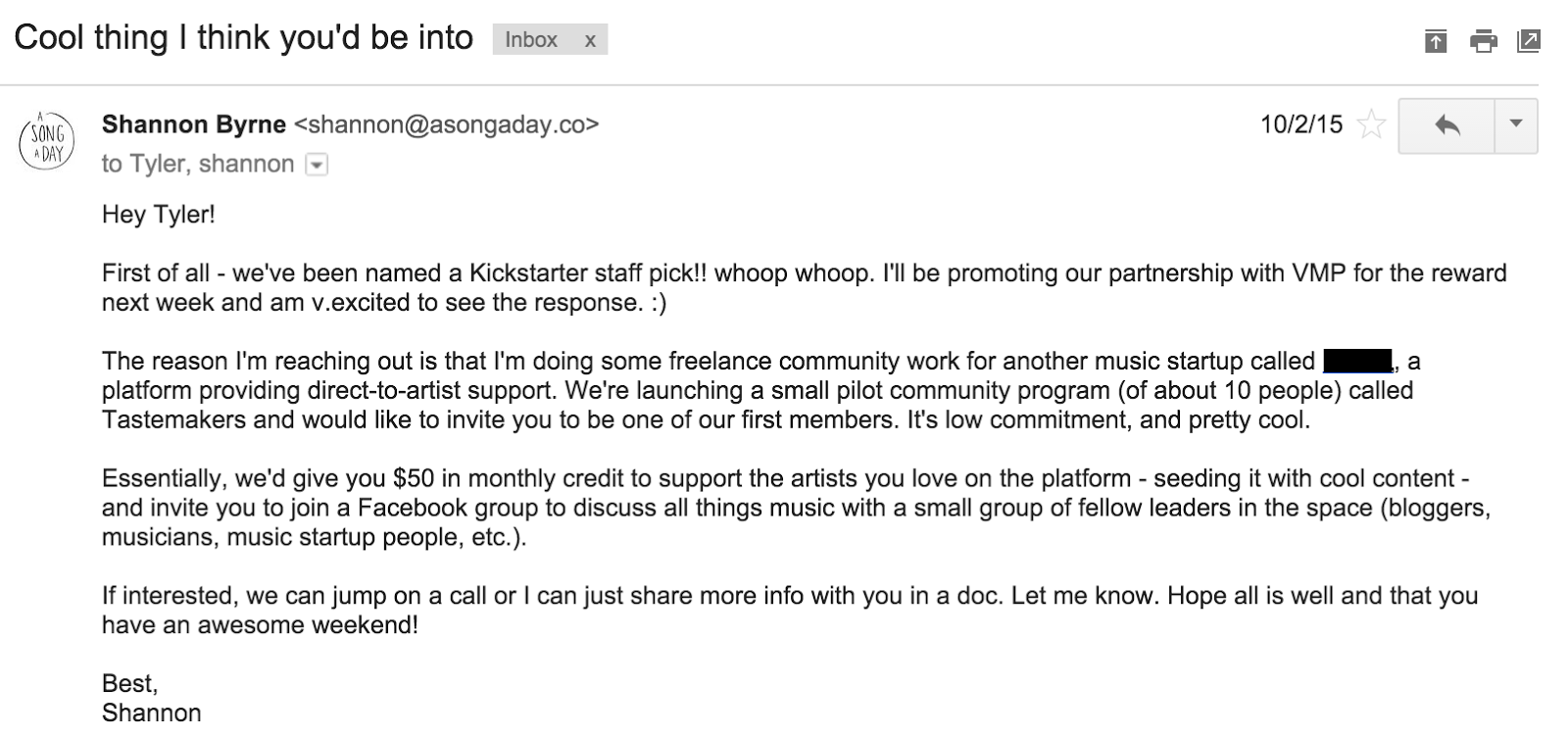
Very casual and mentions a different topic we’d been discussing, but ultimately, effective.
(very) Targeted outreach: If you’re trying to grow a massive community open to people outside of your customer base, outreach is an effective tactic. Identify relevant newsletters, publications, and blogs to share your community with (this Copyblogger article will be helpful).
Craft a short and compelling message communicating why their audience will want to get involved (a common theme here). There’s several tools available for identifying relevant outlets such as BuzzSumo (for finding the most shared posts about a given topic) and ContentMarketer.io (for finding email addresses).
Your personal network: Maybe you’re not building a community for an existing brand. Maybe you’re building a community that could turn into a brand.
That’s kind of what happened to me with A Song A Day. I had thrown a curator signup form on the site, which saw a ton of submissions when it went viral. But that’s not where I started. I started with friends and friends of friends and people who reached out proactively via Twitter or email.
Anyone who’s begging you to volunteer their help is at least worth listening to. Start with a call to your own network, then go from there.
Still not sure where to start?
Email two of your most engaged customers or readers today and ask them if they’d find value out of interacting with each other. Make an intro and see what comes from it.
Do you feel ready to start a community?
Add A Comment
VIEW THE COMMENTS